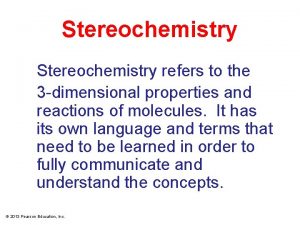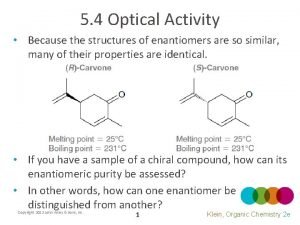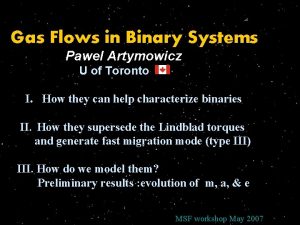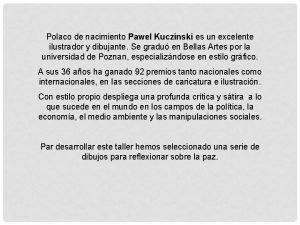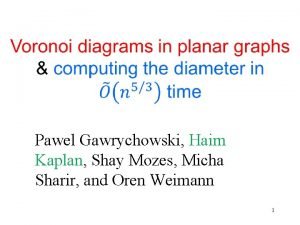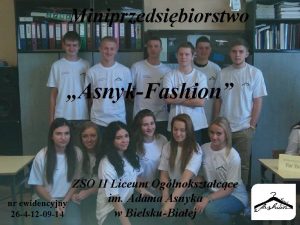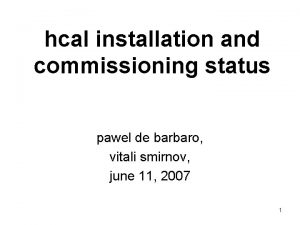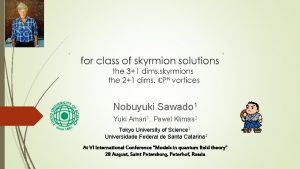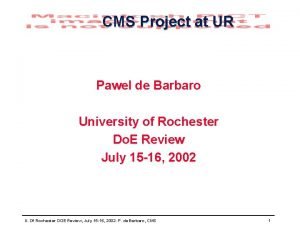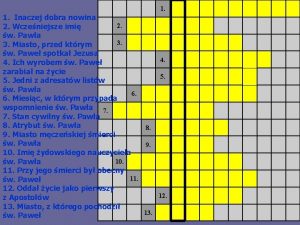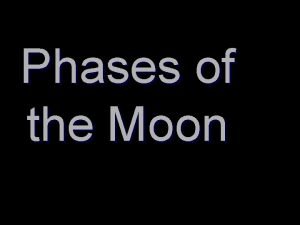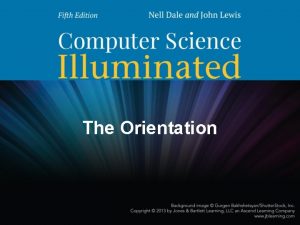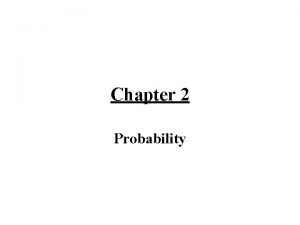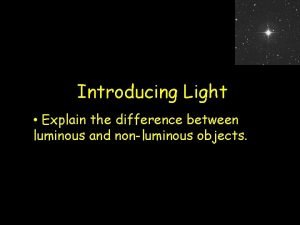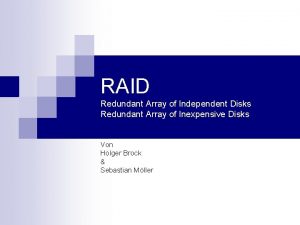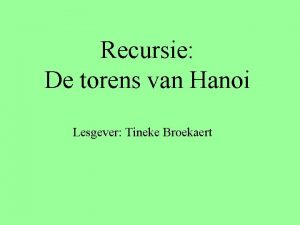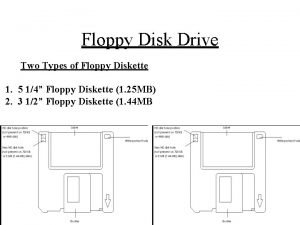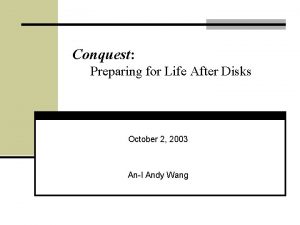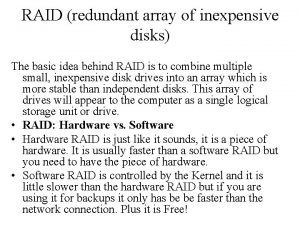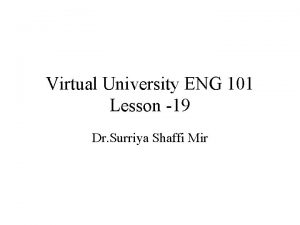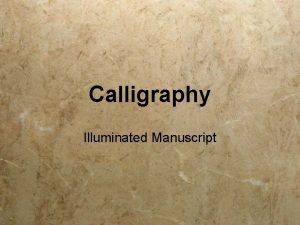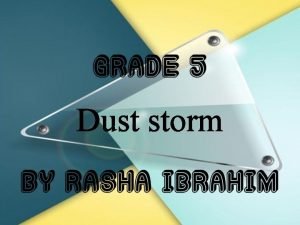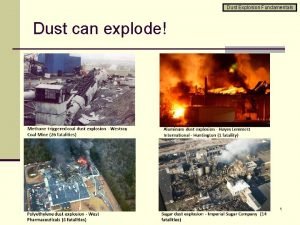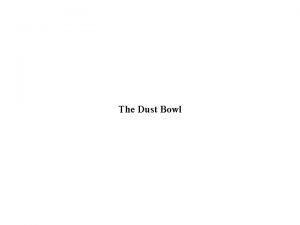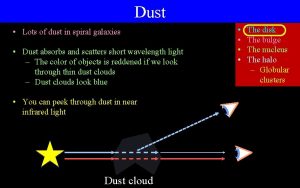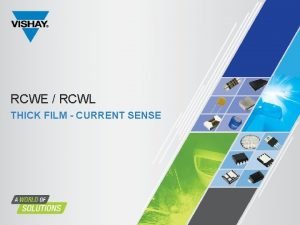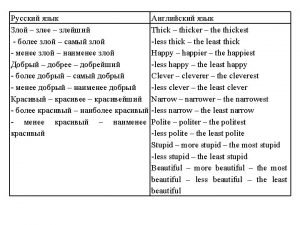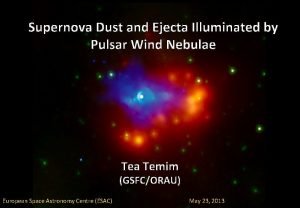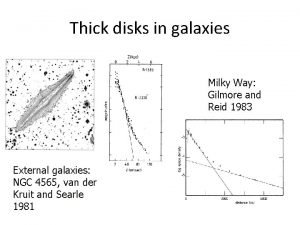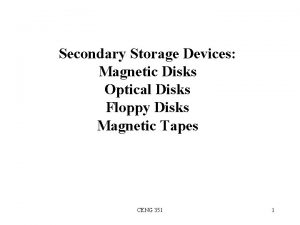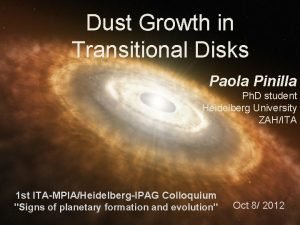Structures in illuminated optically thick dust disks Pawel

































- Slides: 33

Structures in illuminated, optically thick dust disks Pawel Artymowicz, Jeffrey Fung U of Toronto 1. Origin of the observed structure in disk 2. Disks with structure but without planet Signposts of Planets GSFC, 18 Oct. 2011

HD 141596

FEATURES in disks: (9) THEIR ORIGIN: (11) LOTS OF CONNECTIONS (~50) ! blobs, clumps ■(5) streaks, feathers ■(4) rings (axisymm) ■(2) rings (off-centered) ■(7) inner/outer edges ■(5) disk gaps ■(4) warps, uneven wall ■(7) spirals, quasi-spirals■(8) tails, extensions ■(6) ■ instrumental artifacts, variable PSF, noise, deconvolution etc. ■ background/foreground obj. ■ planets (gravity) ■ stellar companions, flybys ■ dust migration in gas ■ dust blowout, avalanches ■ episodic release of dust ■ ISM (interstellar wind) ■ stellar wind, magnetism ■ collective eff. : self-gravity or the tau > 1 instability

Weak/no PAH emission Neutral (grey) scattering from s> grains Size spectrum of dust has lower cutoff Repels ISM dust Disks = Nature, not nurture! Radiative blow-out of grains ( -meteoroids, gamma meteoroids) Instabilities (in disks) Radiation pressure on dust grains in disks Dust avalanches Limit on f. IR Quasi-spiral structure in gas-free disks Enhanced erosion; shortened dust lifetime Orbits of stable meteoroids are elliptical Color effects Short disk lifetime Dust migrates, forms axisymmetric rings, gaps (in disks with gas) Age paradox

Structure in dusty disks Dust-gas interaction: axisym. rings (Takeuchi Overinterpreted observations (noise, background objects) Planets and other perturbers Dust avalanches, optical thickness <<1 but > ( LIR/L*. ~ 3 e-3) and Artymowicz 2001) Create large gaps! Optical thickness > 1 non-axisymmetric instabilities

Outward Migration of Jupiter-like planet in a MMSN-like disk.

Outward migration type III of a Jupiter Inviscid disk with an inner clearing & peak density of 3 x MMSN Variable-resolution, adaptive grid (following the planet). Lagrangian PPM. Horizontal axis shows radius in the range (0. 5 -5) a Full range of azimuths on the vertical axis. Time in units of initial orbital period.

Dust Avalanche (Artymowicz 1997) Process powered by the energy of stellar radiation N ~ exp (optical thickness of the disk * <#debris/collision>) N = disk particle, alpha meteoroid ( < 0. 5) = sub-blowout debris, beta meteoroid ( > 0. 5)

the Ratio of the infrared luminosity (IR excess radiation from dust) to the stellar luminosity; it gives the percentage of stellar flux midplane optical thickness absorbed, then re-emitted thermally multiplication factor of debris in 1 collision (number of sub-blowout debris) Simplified avalanche equation Solution of the simplified avalanche growth equation The above example is relevant to HD 141569 A, a prototype transitional disk with interesting quasi-spiral structure. Conclusion: Transitional disks MUST CONTAIN GAS or face self-destruction. Beta Pic is among the most dusty, gas-poor disks, possible.

ISO/ISOPHOT data on dustiness vs. time -1. 8 uncorrected ages ISOPHOT ages, dot size ~ quality of age Dominik, Decin, Waters, Waelkens (2003) corrected ages ISOPHOT + IRAS fd of beta Pic = maximum dustiness of disks

Grigorieva, Artymowicz and Thebault (A&A, 2007) Comprehensive model of dusty debris disk (3 D) with full treatment of collisions and particle dynamics.

Main results of modeling of collisional avalanches: 1. Strongly nonaxisymmetric, growing patterns 2. Substantial, almost exponential multiplication 3. Morphology depends on the amount and distribution of gas, in particular on the presence of an outer initial disk edge

Structure in dusty disks Overinterpreted observations (noise, background objects) Planets and other perturbers Dust avalanches, optical thickness <<1 but > ( LIR/L*. ~ 3 e-3) Dust-gas interaction: axisym. rings (Takeuchi and Artymowicz 2001) Optical thickness > 1 non-axisymmetric instabilities

Theory of the tau>1 instability in disks. Ingredients of the instability: Axisymmetric disk of opaque gas or Point source of gravity radiation pressure on gas/dust Isn’t it stable? . . dust w/shadowing

Radiation pressure on a coupled gas+dust system that has a spiral density wave with wave numbers (k, m/r), is analogous in phase and sign to the force or self-gravity. The instability is thus pseudo-gravitational in nature and can be obtained from a WKB local analysis. Forces of selfgravity Forces of radiation pressure in the inertial frame (notice their gradient!) Forces of rad. pressure relative to those on the center of the arm

The instability is thus pseudo-gravitational in nature and can be obtained from a WKB local analysis. effective coefficient for coupled gas+dust r (this profile results from outward dust migration; Chiang & Murray-Clay 2007; Dominik & Dullemond 2011 did not consider coagulation)

Step function of r or constant 2 (WKB)

Step function of r or constant 2 (WKB)

Previously just this inverse Safronov-Toomre number Now: 2 Effective Q number (selfgravity + radiation) 1 r Analogies with gravitational instability ==> similar structures (? )

radius Free particles casting shadows tau = 2, beta = 0. 2 1. 6 1 . 7 0 180 deg azimuthal angle 360 deg

radius Free particles casting shadows tau = 4, beta = 0. 2 1. 6 1 . 7 0 180 deg azimuthal angle 360 deg

radius Free particles casting shadows tau = 12, beta = 0. 2 1. 6 1 . 7 0 180 deg azimuthal angle 360 deg

Beta = 0. 2 De Val Borro & Artymowicz (2008, unpubl. ), FLASH hydrocode

Beta = 0. 2

Beta = 0. 2

Azimuthal angle (0 -360 deg) tau = 3 beta = 0. 075 PPM gas disk density soundspeed c/vk = 0. 05 Navier-Stokes viscosity: alpha = 0 1 2 3 radius

Azimuthal angle (0 -360 deg) tau = 4 beta = 0. 15 PPM gas disk density soundspeed c/vk = 0. 05 Navier-Stokes viscosity: alpha = 0 1 2 3 radius

NOT

CPU=Intel 4 -core n. Vidia Ge. Force graphics processors

n. Vidia CUDA = extended C-language for GPU programming up to 5 TFLOP/s using one computer Cudak 1 2 TFLOP, 484 cores Cudak 2 3 TFLOP , 724 cores Cudak 3 5+ TFLOP, 1444 cores all: max 10+ TFLOP, 2652 cores

PPM hydrodynamical simulation on GPU of a gas+embedded dust disk around with effective beta = 0. 15 and total optical depth tau|| =15 Please see Jeffrey Fung’s poster on linear modal analysis which confirms that irradiated disks have a wide variety of unstable modes!

Not only planets but also Gas + dust + radiation => non-axisymmetric features in gas-poor and gas-rich disks, & TIME VARIABILITY due to radial, azimuthal and vertical variations in them. m=1 m>1 one armed spirals, conical sectors, blobs and warps (due to avalanching) multi-armed wavelets and vortices (due to tau>1 radiation pressure instability) + many other possible causes

FEATURES in disks: (9) THEIR ORIGIN: (11) LOTS OF CONNECTIONS (~50) ! blobs, clumps ■(5) streaks, feathers ■(4) rings (axisymm) ■(2) rings (off-centered) ■(7) inner/outer edges ■(5) disk gaps ■(4) warps, uneven walls ■(7) spirals, quasi-spirals■(8) tails, extensions ■(6) ■ instrumental artifacts, variable PSF, noise, deconvolution etc. ■ background/foreground obj. ■ planets (gravity) ■ stellar companions, flybys ■ dust migration in gas ■ dust blowout, avalanches ■ episodic release of dust ■ ISM (interstellar wind) ■ stellar wind, magnetism ■ collective eff. : self-gravity or the tau > 1 instability
 Properties of diastereomers
Properties of diastereomers Ochem optically active
Ochem optically active When light travels from an optically denser medium
When light travels from an optically denser medium Calculating specific rotation from observed rotation
Calculating specific rotation from observed rotation Pawel kowalski
Pawel kowalski Pawel kuczynski apple
Pawel kuczynski apple Leak detection oxford
Leak detection oxford Pawel artymowicz
Pawel artymowicz Pawel kuczinski
Pawel kuczinski Shay mozes
Shay mozes Ilustraciones pawel kuczynski
Ilustraciones pawel kuczynski Pawel pys
Pawel pys Pawel de barbaro
Pawel de barbaro Pawel klimas
Pawel klimas Fullrbx
Fullrbx Miasto przed ktorym sw pawel spotkal jezusa
Miasto przed ktorym sw pawel spotkal jezusa How are the whale flipper and the human arm different
How are the whale flipper and the human arm different How is the moon illuminated
How is the moon illuminated Raid nedir
Raid nedir Illuminated manuscript font
Illuminated manuscript font Computer science illuminated (doc or html) file
Computer science illuminated (doc or html) file Probability learning objectives
Probability learning objectives 5 difference between luminous and non luminous objects
5 difference between luminous and non luminous objects Computer parts labeling
Computer parts labeling Holger brock
Holger brock 0 illuminated moon
0 illuminated moon Tower of hanoi 4 disks
Tower of hanoi 4 disks Aka.ms.sqlcapacity
Aka.ms.sqlcapacity Types of floppy disks
Types of floppy disks Conquest data disks
Conquest data disks Examples of magnetic storage devices
Examples of magnetic storage devices Computer science illuminated chapter 4 answers
Computer science illuminated chapter 4 answers Raid redundant array of inexpensive disks
Raid redundant array of inexpensive disks Disks and tapes can be stored ------- a library. eng101
Disks and tapes can be stored ------- a library. eng101
